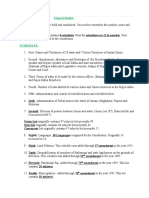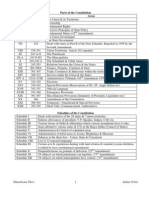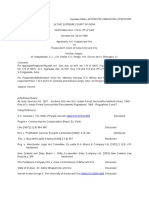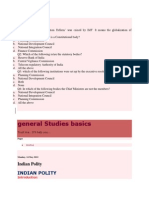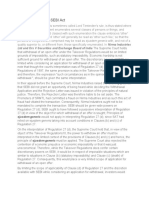0 ratings0% found this document useful (0 votes)
2K viewsIndian Constitution
Indian Constitution
Uploaded by
aashikapriya3037The document summarizes the key components of the Indian Constitution:
1. It consists of 3 parts - the Preamble, Body (395 Articles), and Schedules (12).
2. The Schedules cover important topics like the territorial jurisdiction of states, salaries of government officials, oaths and affirmations, division of powers between central and state governments, and recognized languages.
3. Over time, amendments have changed some parts of the Constitution. For example, the 42nd Amendment added the words "Socialist" and "Secular" to the Preamble and is known as the "Mini Constitution" due to its wide-ranging changes.
Copyright:
© All Rights Reserved
Available Formats
Download as DOCX, PDF, TXT or read online from Scribd
Indian Constitution
Indian Constitution
Uploaded by
aashikapriya30370 ratings0% found this document useful (0 votes)
2K views13 pagesThe document summarizes the key components of the Indian Constitution:
1. It consists of 3 parts - the Preamble, Body (395 Articles), and Schedules (12).
2. The Schedules cover important topics like the territorial jurisdiction of states, salaries of government officials, oaths and affirmations, division of powers between central and state governments, and recognized languages.
3. Over time, amendments have changed some parts of the Constitution. For example, the 42nd Amendment added the words "Socialist" and "Secular" to the Preamble and is known as the "Mini Constitution" due to its wide-ranging changes.
Original Description:
q
Copyright
© © All Rights Reserved
Available Formats
DOCX, PDF, TXT or read online from Scribd
Share this document
Did you find this document useful?
Is this content inappropriate?
The document summarizes the key components of the Indian Constitution:
1. It consists of 3 parts - the Preamble, Body (395 Articles), and Schedules (12).
2. The Schedules cover important topics like the territorial jurisdiction of states, salaries of government officials, oaths and affirmations, division of powers between central and state governments, and recognized languages.
3. Over time, amendments have changed some parts of the Constitution. For example, the 42nd Amendment added the words "Socialist" and "Secular" to the Preamble and is known as the "Mini Constitution" due to its wide-ranging changes.
Copyright:
© All Rights Reserved
Available Formats
Download as DOCX, PDF, TXT or read online from Scribd
Download as docx, pdf, or txt
0 ratings0% found this document useful (0 votes)
2K views13 pagesIndian Constitution
Indian Constitution
Uploaded by
aashikapriya3037The document summarizes the key components of the Indian Constitution:
1. It consists of 3 parts - the Preamble, Body (395 Articles), and Schedules (12).
2. The Schedules cover important topics like the territorial jurisdiction of states, salaries of government officials, oaths and affirmations, division of powers between central and state governments, and recognized languages.
3. Over time, amendments have changed some parts of the Constitution. For example, the 42nd Amendment added the words "Socialist" and "Secular" to the Preamble and is known as the "Mini Constitution" due to its wide-ranging changes.
Copyright:
© All Rights Reserved
Available Formats
Download as DOCX, PDF, TXT or read online from Scribd
Download as docx, pdf, or txt
You are on page 1of 13
Indian Constitution | Preamble, Body, Schedules
Indian Constitution is something we should know not
only for TNPSC exams, but beyond the exam point of
view too. We can for sure expect few Polity questions
here, the 12 schedules in particular. The TNPSC Group
1, 2, 4, VAO exams all had atleast few questions in this
section
Indian Constitution consists of 3 parts.
1. Preamble (Mugavurai)
2. Body (395 Articles)
3. Schedules (12)
Indian constitution was written from Dec 9 1946 to Nov
26, 1949 spanning a period of 2 years 11 months 18
days
PREAMBLE (Mugavurai)
Starts with We the People of India Hence,
preamble is the one said to be given by People.
Sidenote: Union of States, not Federation of States.
(Makkal Sernthu uruvanathu than India, Maanilangal
(Thesangal) sernthu uruvanathu alla)
Few Cases to Note:
1960 Berubari Union Case It (Preamble) is not a
part of Constitution
1973 Kesavananda Bharati Case It is a part of
Constitution
Berubari Union Case: An area, part of West Bengal,
between East & West Bengalcalled Kuch Puri a zig
zag like place where people will have homes in India
(WBengal) and their lands in Bangladesh (EBengal).
After Bangladesh emerged as a nation, India gave the
Berubari Union to Bangladesh so that people have one
administration.
As a result, people of WBengal went to court which
confirmed giving away of Berubari union to Bangladesh
made valid through 9
th
amendment.
Kesavananda Bharathi case will be dealt in detail under
Fundamental Rights section
LIC of India case (1995)
1976 In 42
nd
Amendment, 3 words were added to the
Preamble. Socialist, Secular, Integrity
As we have lot of changes done in 42
nd
amendment, it
is also called as a Mini Constitution.
This 42
nd
amendment came into place due to the 1973
Kesavananda Bharathi case which said Preamble is
part of constitution. Hence making any changes
(including those 3 words) to the preamble needed an
amendment. Hence the 42
nd
amendment.
Schedules: (12 in total; previously 8)
Below are what each of the 12 schedules talks about.
Often repeated TNPSC Group 2, Group 4 questions in
Polity are mostly from these sections.
1
st
Schedule: Name & Territorial Jurisdiction of States
& Union Territories.
2
nd
Schedule: Salary, Emoluments & allowances of
Staffs. (Sambalam matrum ithara padigal)
Not everybody comes under 2
nd
schedule. Below are
the list of people applicable under this.
- President of India
- Governor of States
- Speaker & Deputy speakers of Lok Sabha
- Chairman & Vice Chairman of Rajya Sabha
NB: Vice President is the chaiman of Rajya Sabha.
Hence he receives salary only as the Chairman of
RS. Vice President doesnt have a salary. In case of
the Vice President taking role of President on
emergency, he takes salary of President.
Speaker & Deputy speaker of Legislative assemble
(Maanila Sattasabai)
Chariman & Vice Chairman of Legislative council
(Satta Melavai)
Legislative Council is active only in 6 States,
Karnataka, Andhra, Maharasthra, Bihar, UP, J&K.
It was dissolved in Tamilnadu during MGR rule in
1986, and Ma Po Si was the leader of Legislative
Council during that time.
Article 169 Power to Creation & abolotion of
Legislative Council, by bringing a Theermanam in
Legislative assembly.
Legislative council is basically used to employ
some knowledgeable persons to make use of their
service who cannot win the polls and dont have
much people support. (Similar to Rajya sabha in
the centre)
The first CM to be elected through Legislative
council is Rajaji. (Nominated member to LC by
Governor)
- The Judges of Supreme Court
- The Judges of High court
Attorney General (President nominates) / Advocate
General (Governor Nominates) doesnt have fixed
salary. Only based on cases, hence doesnt come
under Schedule 2.
- CAG Comptroller and Auditor General
(Thalamai Thanikkai Adhigaari)
3
rd
Schedule: Oaths & Affirmation (Uruthimozhi &
Pathiyerppu Vaakumoolam or Ragasiya Kaapu
pramanam)
- Union Ministers
- Candidates for election to the Parliament
- Members of Parliament
- Supreme Court Judges
- CAG Comptroller and Auditor General
- State Ministers (NB: Minister of States (Inai
Amaichargla) & State Ministers (Maanila Amaichargal)
are different)
- Candidates for election to State Legislature (State
Legislature = Legislative Assemble & Legislative
Council)
- Members of State Legislature
- Judges of High Court
4
th
Schedule: Allocation of Seats in the Rajya Sabha
(Max allowed Members 250; Currently 245, those 5
reserved for PoK in case it joins India)
12 Nominated seats for people belonging to Cultural,
Social, Scientific, Education. (Sachin Tendulkar was
nominated under Social category)
So, 245 12 = 233. These 233 are selected via
elections. Out of which 4 are from Union Territories and
229 from States.
Total 7 Union Terrritories & only in 2 (Delhi &
Pudhucherry) we have Sattasabai. So those 4 seats of
UT, 3 from Delhi & 1 from Pudhucherry.
From TN, 18 Rajya Sabha members. (Tamilnadu
assembly members 234. And every 2 years, we select
6 people. (1/3
rd
of 18 members) Hence 234 / 6 = 39.
Those having support of 39 MLAs will get one Rajya
Sabha MP)
NB: Nominated MPs are normally not appointed as
Ministers. (However not mentioned in Constitution, but
a practice)
When Rajya Sabha was created in 1952, it was created
with only 1/3
rd
members. And in 1954 the next
1/3
rd
members appointed and in 1956 the final
1/3
rd
were appointed. So there will be election to Rajya
Sabha every 2 years. (6 years tenure of RS members)
Period of Rajya Sabha Members is 6 years. Rajya
sabha members are elected by State MLAs.
5
th
Schedule: Administration of Scheduled and
Scheduled Tribal area other than Assam, Tripura,
Mizoram & Megalaya (Easy to remember: ATM
2
)
6
th
Schedule: Administration of Tribal peoples in
Assam, Tripura, Mizoram & Megalaya
7
th
Schedule: Division of Powers between the Centre &
State. (Mathiya Maanaila arasugalin Adhigaara
pagirvu)
- List 1: Union List (Mathiya Patiyal) > 97 100
Powers (100
th
& recently added: Service Tax added via
88
th
Amendment in 2003)
- List 2: State List (Maaila Patiyal) > 66 to 61
- List 3: Concurrent List (Pothu Pattiyal) -> 47 to 52
In 1976, via 42
nd
Amendment 5 powers of List 2 has
been moved to List 3 Hence the change from 66 to
61 & 47 to 52. (Education, Marriage, Forest, Weight
& Measures and 1 other which are the 5 items
moved to list 3)
8
th
Schedule:
- Talks about 22 recognized Regional languages
- 14 Languages were in the beginning. 15
th
added
was Sindhi Language via 21
st
Amendment in 1967.
- 16
th
, 17
th
& 18
th
languages (Konkani, Manipuri,
Nepali) were added as part of 71
st
amendment in 1992.
NB: Konkani uses English script, spoken in Goa. Naga
too uses English script
- 92
nd
Amendment in 2003 added 4 other
languages Bodo (Assam), Dongri (J&K), Maithili,
Santhali.(spoken by Tribal people of Orissa, Bihar,
Jharkand)
NB: Bhojpuri (spoken in Bihar) is requested to be
added as 23
rd
language.
9th Schedule: (All those amendments (made via Article
368) will be in 9
th
Schedule; Anything in 9
th
schedule
doesnt have a judiciary review (Needhi Maruaaivu)
Ex Reservation, Zamindari act, Land reforms etc
Any amendment to constitution will be done only via
Article 368.
- Created as part of 1
st
Amendment in 1951
- Chempakkam Dorairajan case vs Madras Court
NB: Due to Reservation policy, a Brahmin student from
Chempakkam didnt get a Medical seat. So he filed a
case for which the verdict was that the judges advised
to add Reservation into the constitution as by Article 13
every citizen are equal. (Article 13 Fundamental
Rightsa meerum yethuvum Article 13 padi sellathathu
aagividum)
- By 1973 Kesavananda Bharathi case,
9
th
Schedule cannot be questioned. Later, in 2007 YB
Sabarval Chief Justice has said that the 69%
Reservation in Tamilnadu can be questioned even if it
is under 9
th
amendment.
- 1993 94 by 76
th
Amendment, the 69%
reservation was made possible, but after YB Sabarval
judgement this is also under question.
10th Schedule: (Brought twice. First 10
th
schedule was
repealed)
- 1974 Sikkim was made an Associate State (Inai
Maanilam) by 35
th
Amendment
- The article 2A, 10
th
schedule newly added.
- 1975 36
th
Amendment made to make Sikkim a
Regular State.
- After making it a regular state, 10
th
Schedule and
2A was replealed as it is no more an Associate state
and doesnt need a separate schedule.
The 10
th
Schedule (52
nd
Amendment) was again
brought back in 1985 for Anti Defection law. (Katchi
Thaaval Thadai Sattam) Background: 1984 Indira
Gandhi was assanitated, Rajiv Gandhi an
inexperienced took over. Due to fear of MLSs going to
another partythis was made.
- If an Independent candidate joins any party, he
will lose the seat based on Anti Defection law. (1926
Independent Candidate as Chief Minister of TN
Mr.Subbarayan; MadhuKoda in Jharkhand on 2008, an
Independent candidate as CM)
- Nominated Members If they join a party within 6
months from the date of nomination they are safe, else
they loose their seat too.
- If less than 1/3 in a Party leave together they will
loose their seats. If more than 1/3
rd
leave from a party it
is considered a Split in the party.
11th Schedule: RLB (Rural Local Bodies) Ooraga
Panchayatugal
- Created via 73
rd
Amendment Panchayat Raj Act
- 1952 Community Development program
(Nehrus flagship program) Samudhaya Valarchi
Thittam.
Creation of blocks of 65000 people each. And each
block will have all facilities of a Towship including
hospitals, entertainment etc
- 1953 National Extension Service (Desiya Viruvu
Pani Thittam)
- 1957 Balwanth Rai Mehtha Committee, was
installed to find out the reasons for the failures of
Community Development program.
It suggested 3 tier panchayat (Village Level,
Panchayat Union Level, District Panchayat or Jilla
Parishat)
Suggested formation of Local Leaders
First Election -> 1959 Oct 2, Nagar District of
Rajasthan
- Not every state followed the 3 tier advisory. Ex TN
followed 2 tier only. WB followed 4 tier, Rajasthan, AP
etc followed 3 tier.
- Regular election did not happe either.
Ashok Mehta Committee (2 tier Committee) 1978.
(Janata Party) (Panchayat Union & District Panchayat
2tiers) Even after this the elections did not happen
regularly. So, in 1985 86 Rajiv Gandhi appointed LM
Singhvi committee to find out the reasons. L.M. Singhvi
committee recommended that the Panchayat Raj
elections be added to Constitution. And recommended
the 3 tier model recommended by Balwanth Rai
Mehtha Committee.
73
rd
Amedment 1992 Pachayat Act Made effective
from April 24 1993.
TN made this effective on April 23 1994. (Any act by
Centre should be implemented by State within I 1year.
TN made it effective exactly a day before J)
NB: Cooperative society elections held every 5 years
should be done without fail as it was added to the
constitution via 97
th
Amendment in 2011.
12
th
Schedule:
74
th
Amendment: Nagarpalika Act. (ULB Urban
Local Bodies) Importance to Urban areas namely
Corporation, Municipalities, Town Panchayats.
Salient Features of Indian Constitution
The constitution of India is lengthiest and most detailed compared to any constitutions in
the world.
It originally had 395 Articles divided in to 22 parts and 9 schedules. There are 6 Fundamental
Rights in the constitution. India is a secular state meaning the state does not uphold a particular
religion on its own Articles 25 to 28 gives shape to this secularism.
It provides for single citizenship for the whole of India. There is no citizenship for each state.
The preamble of the constitution states India has a Sovereign, Socialist, Secular and
Democratic Republic.
Sovereign: Country does not dependent on any outside authority.
Socialist: Ownership of the revenues of production and distribution by the state insertion
made through 42nt amendment Act.
Democratic: It has the government which gets its authority from the will of the people.
Republic: Indian democracy is based on adult suffrage, where any person who is 18 years of
age and who is otherwise eligible has a right to vote without any discrimination on gender or
religion.
Drafting Constitution:
The Indian constitution was drawn up by constituent assembly (established in
accordance with the Cabinet Mission Plan) initially summoned on Dec 9 1946, under the
presidentship of Sachithanandha Sinha for undivided India. On 1
st
July, 1947 the British
Parliament passed the Indian Independence Act to divide the country into India and Pakistan.
With partition of India the representative of East Bengal, West Punjab, Sindh and Baluchisthan,
N-W Frontier Provenience and the Sylhet District of Assam, which joined Pakisthan, ceased to
be member of constitution assembly. On August 14 1947, the constituent assembly met again
as the Sovereign Constituent Assembly for the Territory of India under the presidentship of
Schithananda Sinha. On the demise of Schithananda Sinha Dr.Rajendra Prasad became the
president of constituent assembly. A draft constitution was published Feb 1948. 284 out of 299
members affixed their signature to the constitution finally adopted it on 26
th
Nove 1949. It came
into effect on 26
th
Janu 1950.
Drafting Committee:
Chairman: Dr.B.R.Ambedkar. Members: Alladi Krishnaswamy Iyyar, N.Gopalswami Iyangar,
Syed Md.Saadulla, Dr.K.M.Munshi, B.L.Mitter (was replaced by N.Madhava Rao), and
D.P.Khaitan (was replaced by T.T.Krishnamaachari).
The work started with the presentation of the Objective Resolution moved by
Jawaharlal Nehru was adopted on Jan 22 1947. The committee for scrutinizing draft constitution
and suggesting amendments was formed Aug 29 1947. The draft was prepared by Feb 1948.
The constituent asssembly met three times to read the draft Clause by Clause in Nov 1948, Oct
1949 and Nov 1949. After the 3
rd
reading, it was signed by the Indian President and was
adopted on Nov 26 1949. In fact, a Committee on Rules of Procedure was in place as early as
Dec 1946.
The constitution of India closely follows the British-Parliamentary model but differs from
it in 1 aspect that is, the Constitution is supreme, not Parliament. Hence, the Indian courts are
conferred with the authority to adjudicate on the constitutionality of any law enacted by the
Indian Parliament.
The Indian Constitution consists of the following:
1. The Preamble,
2. Parts I to XXII covering articles 1 to 395,
3. Schedules 1 to 12
4. Appendix. Part IX and Schedule XI (Article 243-G) have been incorporated under 73
rd
Constitution Amendment Act 1992.
The Fundamental Rights:
The Right to Equality
Right to Freedom
Right against Exploitation
Right to Freedom of Religion
Cultural and Educational Rights
Right to Constitutional Remedies
The Fundamental Duties:
To abide by the Constitution & respect the ideals and Institutions.
To reverence the National Flag and National Anthem.
To realize and follow the vital ideals of secularism, democracy and non-violence.
To preserve the culture and heritage of our nation.
To guard the Sovereignty, Unity and Integrity of our nation.
To safeguard the public property.
To protect the country even at the cost of our life.
To protect natural resources.
To strictly avoid dowry, Gambling and other social evils.
To endeavor towards excellence in the respective spheres of activities of the individuals.
You might also like
- Civil Procedure Exam NotesDocument146 pagesCivil Procedure Exam Noteskazza91No ratings yet
- Mission Order Travel OrderDocument1 pageMission Order Travel OrderConcepcion Mps100% (1)
- Loan (Articles 1933 - 1961)Document16 pagesLoan (Articles 1933 - 1961)Carlos JamesNo ratings yet
- General StudiesDocument14 pagesGeneral StudieskondareddyNo ratings yet
- Indian Polity PDFDocument25 pagesIndian Polity PDFAnonymous iQMKqMqqWNo ratings yet
- Indian PolityDocument25 pagesIndian PolitySharad GuptaNo ratings yet
- 12 ScheduleDocument6 pages12 ScheduleHackerzillaNo ratings yet
- Indian Polity For JKSSB Exams by Triple SDocument21 pagesIndian Polity For JKSSB Exams by Triple Ssukritichib30No ratings yet
- ICO - RnsitDocument15 pagesICO - Rnsitmonkeydluffy0505kaizokuNo ratings yet
- SSCDocument5 pagesSSCaryangupta.unusedNo ratings yet
- The Constitution of IndiaDocument56 pagesThe Constitution of IndiaMayank SainiNo ratings yet
- Polity Class NotesDocument171 pagesPolity Class NotesPravallika DarlaNo ratings yet
- Indian PolityDocument26 pagesIndian Politymanya_borudeNo ratings yet
- POLITY 1.0 by Abhas SainiDocument39 pagesPOLITY 1.0 by Abhas SainiKeshav BhartiNo ratings yet
- Lecture Notes On PolityDocument25 pagesLecture Notes On PolitysanojsanjeevpersonalNo ratings yet
- Polity Class 01-WPS OfficeDocument184 pagesPolity Class 01-WPS Officeakashblog6No ratings yet
- Polity Top 500 Q&A-1Document18 pagesPolity Top 500 Q&A-1Aman TiwariNo ratings yet
- Legal Environment of Bangladesh, Lecture - 7Document28 pagesLegal Environment of Bangladesh, Lecture - 7Md Sabbir Ahmed EkhonNo ratings yet
- U Aoqd Ly KEp To 7 FUpz 31 FmoDocument120 pagesU Aoqd Ly KEp To 7 FUpz 31 Fmoyakshgiri5No ratings yet
- 12 Schedules of Indian Constitution Upsc Notes 35 PDFDocument6 pages12 Schedules of Indian Constitution Upsc Notes 35 PDFRabiul HaqueNo ratings yet
- Polity and ConstitutionDocument20 pagesPolity and ConstitutionamanyadavataliNo ratings yet
- GV Kaksha Polity Revised in English Join (@Apna_pdf)Document85 pagesGV Kaksha Polity Revised in English Join (@Apna_pdf)deepakbehera.pinkyNo ratings yet
- Structure of Government of IndiaDocument8 pagesStructure of Government of IndiaDheeraj YadavNo ratings yet
- AK Kraipak and Ors Vs UOI - AIR 1970 SC 150Document9 pagesAK Kraipak and Ors Vs UOI - AIR 1970 SC 150KARTHIKEYAN MNo ratings yet
- 211121 SDocument26 pages211121 SRasheed KhanNo ratings yet
- Indian PolityDocument14 pagesIndian PolitySukantaBanikNo ratings yet
- Constitution of India - Structure and FeaturesDocument18 pagesConstitution of India - Structure and FeaturesAkshay Ramesh50% (4)
- PolityDocument55 pagesPolityheyitsme.kforkuldeepNo ratings yet
- Parliment of IndiaDocument40 pagesParliment of IndiaSandeep KattiNo ratings yet
- Polity Revision - Class 1Document36 pagesPolity Revision - Class 1parinithabs974No ratings yet
- Indian Polity Notes by AXOM IAS AcademyDocument8 pagesIndian Polity Notes by AXOM IAS Academyrajibbordoloi7No ratings yet
- Basic Structure Doctrine - Constitution - YG Law - 5577612 - 2023 - 10 - 02 - 17 - 10Document6 pagesBasic Structure Doctrine - Constitution - YG Law - 5577612 - 2023 - 10 - 02 - 17 - 10Gautam Kr. Ranjan (B.A. LLB 16)No ratings yet
- GK - MegadocDocument300 pagesGK - Megadocrishona.bhatiNo ratings yet
- Political System of PakistanDocument17 pagesPolitical System of Pakistansahilkhan45456677No ratings yet
- Tusharika DeepanshuDocument13 pagesTusharika DeepanshuArchie AndrewsNo ratings yet
- NCERT Polity Class 11Document10 pagesNCERT Polity Class 11Jeevan BennyNo ratings yet
- Class 19 Telangana Regional CommitteeDocument23 pagesClass 19 Telangana Regional Committeepuganacious nightcrawlerNo ratings yet
- Complete Indian Polity Capsule For SSC DP SSC GD 2024Document29 pagesComplete Indian Polity Capsule For SSC DP SSC GD 2024Umang Verma Rollno-7No ratings yet
- 5 6055386678808282402Document19 pages5 6055386678808282402Yogendra SolankiNo ratings yet
- Unit-1 ICDocument12 pagesUnit-1 ICMudit VashisthaNo ratings yet
- List of Imp Ammendments in Indian ConstitutionDocument9 pagesList of Imp Ammendments in Indian ConstitutionParveen SainiNo ratings yet
- Indian Constitution: Presenter: Indu Bala Moderator: Ms. Amali Mery Nursing Tutor, Aiims, RishikeshDocument60 pagesIndian Constitution: Presenter: Indu Bala Moderator: Ms. Amali Mery Nursing Tutor, Aiims, RishikeshIndu Bala100% (1)
- 21CIPDocument34 pages21CIPPravaal Raj MishraNo ratings yet
- Lax 2Document56 pagesLax 26qqgffwjjfNo ratings yet
- Part B 1. About India-C-EDocument39 pagesPart B 1. About India-C-ESaYani SamaDdarNo ratings yet
- AS WB The Indian ParliamentDocument4 pagesAS WB The Indian ParliamentrohanaviNo ratings yet
- Indian Polity (We Focus)Document69 pagesIndian Polity (We Focus)siddhartha50% (2)
- Indian Constitution Originally Had Eight SchedulesDocument2 pagesIndian Constitution Originally Had Eight SchedulesAnshuman TagoreNo ratings yet
- Constitution IDocument49 pagesConstitution Iajaybc2104No ratings yet
- 73 AND 74 Amadement Act.: RD THDocument18 pages73 AND 74 Amadement Act.: RD THAnonymousNo ratings yet
- AppscDocument76 pagesAppscmurali42050% (2)
- Career Anna Static GK Ebook On PolityDocument25 pagesCareer Anna Static GK Ebook On PolityRitesh RamanNo ratings yet
- PoDocument117 pagesPoxyz23510No ratings yet
- ) Write A Note On Fundamental RightsDocument7 pages) Write A Note On Fundamental Rightsarshan.laskar19No ratings yet
- Working of InstitutionsDocument7 pagesWorking of InstitutionsDrMijanur RahamanNo ratings yet
- Indian Constitution RPDocument50 pagesIndian Constitution RPmaskechandrakant2004No ratings yet
- Vanda Is A: Genus Orchidaceae SpeciesDocument1 pageVanda Is A: Genus Orchidaceae Speciesaashikapriya3037No ratings yet
- Random-Access Memory (RAMDocument1 pageRandom-Access Memory (RAMaashikapriya3037No ratings yet
- Neem Oil Has Been Shown To Avert Termite Attack As An Ecofriendly and Economical AgentDocument1 pageNeem Oil Has Been Shown To Avert Termite Attack As An Ecofriendly and Economical Agentaashikapriya3037No ratings yet
- Random-Access Memory (RAMDocument1 pageRandom-Access Memory (RAMaashikapriya3037No ratings yet
- Weave Warp Tension WeftDocument1 pageWeave Warp Tension Weftaashikapriya3037No ratings yet
- Mobility (: Swarm RobotsDocument1 pageMobility (: Swarm Robotsaashikapriya3037No ratings yet
- Lizards Are A Widespread Group ofDocument1 pageLizards Are A Widespread Group ofaashikapriya3037No ratings yet
- Saturn Is The SixthDocument1 pageSaturn Is The Sixthaashikapriya3037No ratings yet
- Whales Are A Widely Distributed and Diverse Group of Fully: FusiformDocument1 pageWhales Are A Widely Distributed and Diverse Group of Fully: Fusiformaashikapriya3037No ratings yet
- Fibres Cellulose Wood Rags Grasses Writing Printing Cleaning China Han Eunuch Cai Lun Pulp and Paper IndustryDocument1 pageFibres Cellulose Wood Rags Grasses Writing Printing Cleaning China Han Eunuch Cai Lun Pulp and Paper Industryaashikapriya3037No ratings yet
- Latin Ancient Greek Crown White Tie Diadem Geoffrey MunnDocument1 pageLatin Ancient Greek Crown White Tie Diadem Geoffrey Munnaashikapriya3037No ratings yet
- Noise Is Unwanted: Sound VibrationsDocument1 pageNoise Is Unwanted: Sound Vibrationsaashikapriya3037No ratings yet
- Faloo DaDocument1 pageFaloo Daaashikapriya3037No ratings yet
- T R.təs. Z/ Ɔ Testudines Predators Carapace Plastron Vertebrates Pectoral Pelvic Girdles Diurnal Crepuscular ReclusiveDocument1 pageT R.təs. Z/ Ɔ Testudines Predators Carapace Plastron Vertebrates Pectoral Pelvic Girdles Diurnal Crepuscular Reclusiveaashikapriya3037No ratings yet
- CitrusDocument1 pageCitrusaashikapriya3037No ratings yet
- Prunus Prunus: Fruit DrupeDocument3 pagesPrunus Prunus: Fruit Drupeaashikapriya3037No ratings yet
- Fruit Citrus Family Rutaceae: Aurantium Is Considered ADocument1 pageFruit Citrus Family Rutaceae: Aurantium Is Considered Aaashikapriya3037No ratings yet
- Leguminous Tree Family Fabaceae Tropical Africa Monotypic Taxon FruitDocument1 pageLeguminous Tree Family Fabaceae Tropical Africa Monotypic Taxon Fruitaashikapriya3037No ratings yet
- Space Shuttle Discovery (: Orbiter Vehicle Designation Orbiters Nasa Space Shuttle Program STS-41-DDocument1 pageSpace Shuttle Discovery (: Orbiter Vehicle Designation Orbiters Nasa Space Shuttle Program STS-41-Daashikapriya3037No ratings yet
- Major Kinds of Cultivated Raspberries: Rubus IdaeobatusDocument6 pagesMajor Kinds of Cultivated Raspberries: Rubus Idaeobatusaashikapriya3037No ratings yet
- TamilnaduDocument1 pageTamilnaduaashikapriya3037No ratings yet
- Polyvinyl ChlorideDocument2 pagesPolyvinyl Chlorideaashikapriya3037No ratings yet
- List of Attorneys General For IndiaDocument2 pagesList of Attorneys General For Indiaaashikapriya3037No ratings yet
- Central Government Santiniketan West Bengal Rabindranath TagoreDocument1 pageCentral Government Santiniketan West Bengal Rabindranath Tagoreaashikapriya3037No ratings yet
- Narcissus Is A: Narcissus Were Well Known inDocument1 pageNarcissus Is A: Narcissus Were Well Known inaashikapriya3037No ratings yet
- What Are Genetically Modified (GM) Foods?Document4 pagesWhat Are Genetically Modified (GM) Foods?aashikapriya3037No ratings yet
- sd1 EngDocument5 pagessd1 EngcrapNo ratings yet
- Latin MaximsDocument5 pagesLatin MaximsAj Guadalupe de MataNo ratings yet
- 20190201115127602Document52 pages20190201115127602Gene KiniskiNo ratings yet
- Ang Gintong Kudong v1.0 PDFDocument30 pagesAng Gintong Kudong v1.0 PDFJen De la CruzNo ratings yet
- Site HandoverDocument3 pagesSite HandoverPaa Kow Dadzie100% (2)
- Final Document - g34-35396-2010 - Application and Enforcement of Electronic Contracts in KenyaDocument63 pagesFinal Document - g34-35396-2010 - Application and Enforcement of Electronic Contracts in KenyaStanza Rao100% (1)
- IEPFDocument5 pagesIEPFachlaNo ratings yet
- Ţurcanu T ViolenţaDocument7 pagesŢurcanu T ViolenţaMerloiu FlorinaNo ratings yet
- School Forms New2Document65 pagesSchool Forms New2PinkyBearNo ratings yet
- Peralta v. QuimpoDocument1 pagePeralta v. QuimpoMigz DimayacyacNo ratings yet
- Facts:: Bpi vs. Intermediate Appellate Court 164 SCRA 630 (1988)Document9 pagesFacts:: Bpi vs. Intermediate Appellate Court 164 SCRA 630 (1988)Bluebells33No ratings yet
- Limited Liability Company WorksheetDocument3 pagesLimited Liability Company WorksheetRocketLawyerNo ratings yet
- Chang Kai Shek School Vs CADocument2 pagesChang Kai Shek School Vs CAJane Dela CruzNo ratings yet
- Reyes vs. LimDocument1 pageReyes vs. LimJoseph MacalintalNo ratings yet
- Requirements For Practice of LawDocument55 pagesRequirements For Practice of LawstephclloNo ratings yet
- De La Merced vs. GSIS DigestDocument4 pagesDe La Merced vs. GSIS DigestXyrus BucaoNo ratings yet
- Violence Against Women in Pakistan Role of Police and Media CASTDocument9 pagesViolence Against Women in Pakistan Role of Police and Media CASTChip FixNo ratings yet
- Interpretition of StatutesDocument4 pagesInterpretition of Statuteszodika khiangteNo ratings yet
- MM301Document6 pagesMM301YogyataMishraNo ratings yet
- Blue Coat License Assignment and Transfer FormDocument6 pagesBlue Coat License Assignment and Transfer FormIrwan DasukiNo ratings yet
- Filipino Grievances Against General Wood UpdatedDocument2 pagesFilipino Grievances Against General Wood UpdatedRachelle RiveraNo ratings yet
- PRPD Consent Decree Yolanda Carrasquillo (Acuerdo Caso Yolanda Carrasquillo)Document22 pagesPRPD Consent Decree Yolanda Carrasquillo (Acuerdo Caso Yolanda Carrasquillo)Emily RamosNo ratings yet
- Pla GarismDocument33 pagesPla GarismKristel YeenNo ratings yet
- Adoption or SonshipDocument12 pagesAdoption or SonshipdarrNo ratings yet
- Phoenix Coyotes Season Ticket License Terms and ConditionsDocument2 pagesPhoenix Coyotes Season Ticket License Terms and ConditionsArizona CoyotesNo ratings yet
- Republic V Espinosa 171514Document18 pagesRepublic V Espinosa 171514Gennard Michael Angelo AngelesNo ratings yet
- Tan V SecDocument4 pagesTan V SecKarminnCherylYangotNo ratings yet



